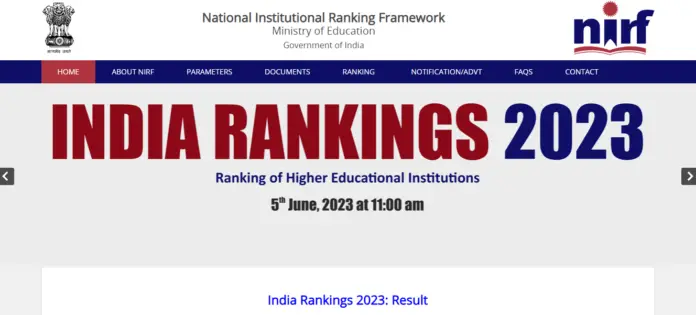The National Institutional Ranking Framework (NIRF) is an initiative by the Government of India that aims to rank educational institutions across the country. The ranking system provides valuable insights into the performance and quality of institutions in various domains. In this article, we will delve into the details of how the NIRF ranking is calculated, shedding light on the parameters and methodology involved.
How NIRF Ranking is Calculated: A Comprehensive Guide to Educational Institution Evaluation
I. Overview of the NIRF Ranking Framework
The NIRF ranking framework evaluates institutions based on a set of parameters that encompass teaching, learning, research, outreach, and overall perception. These parameters are further divided into sub-categories, each carrying a specific weightage in the final ranking calculation.
II. Teaching, Learning, and Resources (TLR)
Under the TLR category, the focus is on evaluating the quality and effectiveness of teaching and learning processes within an institution. The parameters considered include student-teacher ratio, faculty qualifications and experience, faculty-student ratio, and the availability of various resources such as library facilities, laboratories, and classrooms.
III. Research and Professional Practice (RP)
The RP category emphasizes the research output and innovation potential of an institution. Parameters like the number of research papers published, patents filed, and projects undertaken play a crucial role in determining the ranking. Additionally, collaborations with industry and other research institutions are also taken into account.
IV. Graduation Outcomes (GO)
The GO category assesses the institution’s ability to produce employable graduates and their success in securing placements or pursuing higher education. Parameters considered include the placement record, the number of students pursuing higher studies, and the average salary offered to graduates.
V. Outreach and Inclusivity (OI)
The OI category evaluates an institution’s efforts in promoting inclusivity and diversity, as well as its engagement with society at large. Parameters like the number of students from different socio-economic backgrounds, women empowerment initiatives, and social outreach programs are considered.
VI. Perception (PR)
The perception category gauges the reputation and perception of an institution among its peers, employers, and other stakeholders. This parameter is assessed through surveys and feedback collected from academic experts, employers, alumni, and the general public.
VII. Weightage Distribution
Each parameter carries a specific weightage in the overall ranking calculation. The weightages may vary from year to year, and the NIRF provides a detailed breakdown of the weightage distribution for each category and sub-category.
VIII. Data Collection and Verification
To ensure the credibility of the ranking process, institutions are required to submit detailed data and information related to the parameters. The data is thoroughly verified and cross-checked by the NIRF authorities to maintain transparency and accuracy in the rankings.
IX. Calculation and Ranking
Once the data verification is completed, the NIRF calculates the overall score for each institution based on the parameters and weightages. The scores are normalized to account for variations in the scale and magnitude of different parameters. Finally, the institutions are ranked based on their overall scores, and the results are made public.
The NIRF ranking system serves as a valuable tool for students, parents, and educational institutions to assess the quality and performance of educational institutions in India. By considering various parameters like teaching, research, graduation outcomes, outreach, and perception, the ranking provides a comprehensive evaluation of institutions.
Understanding the methodology and parameters involved in the NIRF ranking calculation helps stakeholders make informed decisions while choosing or evaluating educational institutions.
Remember that the NIRF rankings are dynamic and can change from year to year as institutions continue to evolve and improve. It is essential to consider multiple factors and conduct further research while making decisions related to higher education.
NIRF Ranking Categories
The NIRF ranking framework consists of the following categories:
- Overall: This category provides the overall ranking of an institution based on its performance across all parameters.
- Engineering: This category focuses on ranking engineering institutions based on their teaching, research, and other relevant factors.
- Management: This category ranks management institutions, including business schools, based on parameters such as faculty quality, research output, and industry interface.
- Pharmacy: This category assesses pharmaceutical institutions based on factors like research productivity, placement records, and industry collaborations.
- College: This category ranks undergraduate colleges across disciplines, considering parameters such as student strength, faculty quality, and facilities.
- Medical: This category ranks medical institutions, including both medical colleges and hospitals, based on factors like teaching, research, and healthcare services provided.
- Law: This category focuses on ranking law institutions based on parameters like faculty qualifications, research output, and academic excellence.
- Architecture: This category assesses architecture institutions based on factors like faculty strength, student achievements, and design excellence.
- University: This category ranks universities as a whole, considering a range of parameters across disciplines and departments.
- Dental: This category assesses dental institutions based on factors like academic excellence, research productivity, and patient care.
- Research Institutions: This category evaluates standalone research institutions based on their research output, collaborations, and impact on society.
- Overall (Category-specific): In addition to the specific categories mentioned above, the NIRF also provides an overall ranking within each category, allowing institutions to benchmark themselves against others within the same discipline.
- Agriculture and Allied Sectors: newly added in the 2023 ranking.
It’s important to note that these categories may be subject to change or expansion in subsequent NIRF ranking cycles, as the framework continues to evolve and adapt to the changing needs of the education sector.
Disclaimer: The information provided in this article is based on the NIRF ranking framework.
Also Read: Top 50 Research Institutions in India Based on NIRF Ranking 2023


